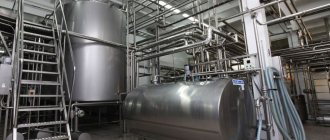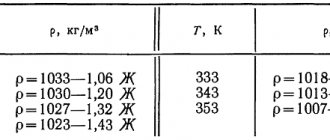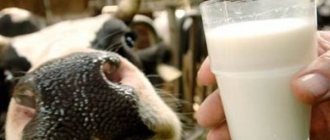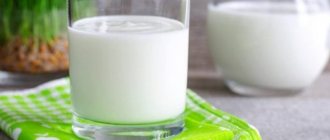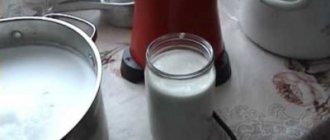Milk is one of the most valuable products. Unfortunately, it quickly deteriorates, which is why it is rarely sold fresh. To extend its shelf life, housewives most often use boiling, after which the protein and mineral composition of the product changes. Not many people know that it is not necessary to actually boil milk. There is an alternative solution that will preserve the necessary properties of the product - pasteurization. Many housewives consider pasteurization a long and difficult task. Whether this is so, we will tell you further.
What is milk pasteurization
The technology of extending the useful life of milk by heating it to the desired temperature and then cooling it for a certain time is called pasteurization. They began to resort to pasteurization of milk from the middle of the last century after the discovery made by the Frenchman Louis Pasteur.
Its essence is that after some manipulations in the liquid the growth of pathogenic bacteria stops. This means that pasteurized milk is safe to eat, it can be stored for a long time, and the taste of the milk does not change.
Currently, different pasteurization modes are used. The temperature treatment option is selected based on the microbiological state of the milk raw material and the product with what shelf life it is necessary to obtain.
What is the difference between pasteurized milk and UHT milk?
Ultrapasteurization is the most commonly used method of milk disinfection, when, with a short temperature exposure, the longest shelf-stable product is achieved while preserving nutritional value and taste characteristics. The technology involves very quickly heating whole milk with steam to the highest possible temperature for no more than 20 seconds, followed by lightning-fast cooling to a temperature at which the milk can be stored in the refrigerator.
The result of this procedure is that living microelements die, but the taste and protein composition of the product is preserved. This milk can be stored in a special sealed package for 6-9 months at room temperature.
That is, the answer to the question “What is the difference between pasteurized milk and ultra-pasteurized milk?” sounds like this: “Ultra-pasteurization is a type and the next stage of pasteurization.” When bottling it, a special aseptic packaging technology is used, in which the container is also disinfected, and the process itself takes place in a sterile environment. A special material is used for packaging here - “tetrapack”, consisting of three layers: polyethylene, cardboard and aluminum.
UHT milk is convenient to take on a long trip; it is allowed to be consumed in its pure form, prepared from it, and used in the nutrition of babies under 1 year of age. An open package of UHT milk, unlike pasteurized milk, can be stored for up to three days.
Sterilized milk is also available on store shelves.
What is the difference between pasteurized milk and sterilized milk?
Sterilization is practically a boiling process, which lasts up to half an hour. For sterilization, milk is heated to a temperature lower than during ultra-pasteurization, and is kept in such conditions for quite a long time - from 20 to 30 minutes. Sterilization of milk turns it into a kind of canned food with an excellent shelf life of up to a year.
Pasteurized milk left at room temperature for several days turns into curdled milk. If you do this with sterilized milk, it will become rotten and it will become impossible to use it for food.
Pros and cons or pitfalls of sterilization
Each milk processing method has positive and negative sides. The most gentle method is used during pasteurization; this milk tastes more like fresh milk. In this case, microorganisms are preserved, so it can be used to create fermented milk products.
The disadvantages of pasteurized milk include the fact that pasteurization does not take place at such a high temperature as sterilization, a number of bacteria, spores and microorganisms do not die, therefore the shelf life of pasteurized milk is much shorter than sterilized milk (from 4-5 days to two weeks in a refrigerator camera).
At home, it is easier to resort to long-term pasteurization. There will then be no need for subsequent boiling of the milk, since such treatment destroys all pathogenic microbes.
Types of milk depending on normalization and fat content
Special processing allows the manufacturer to change its composition, taste, nutritional value, shelf life and other characteristics, in accordance with industry standards.
Selected
Selected milk is a natural product of the highest quality:
- Eliminates mixing of varieties. Produced from high-quality raw materials from one or more farms.
- Maintains natural fat percentage.
- The raw materials are not sterilized or separated, but only pasteurized. This process allows you to preserve most of the beneficial qualities of the product.
Pasteurization methods
Before determining at what temperature milk is pasteurized, we recommend that you familiarize yourself with the methods of such processing. Pasteurization of milk can be carried out in several ways, including: long-term, short-term and high-temperature pasteurization. The temperature regime also depends on the choice of pasteurization method.
Long-term pasteurization is performed quite rarely due to labor costs. It guarantees an almost complete cessation of bacterial activity without changing the properties of the raw material. The technique involves heating to 65 °C for half an hour. Its effectiveness is 99%.
Short-term pasteurization is carried out at a temperature of 72-75 ° C with a short holding time of 15-20 seconds. The effectiveness of the procedure is 98%.
High-temperature or flash pasteurization is essentially close to short-term pasteurization: the milk mass is heated to 85 °C, but without holding. This guarantees microflora suppression by 99.5%. Such processing is done quite rarely for cream, from which butter will later be produced. The ultra-high temperature regime is performed in several steps: in the first step, the temperature of the milk is increased to 70-80 °C. Next, continue heating with steam for a minute to a temperature of 135-150 °C.
Whatever option is chosen, it is important to comply with the specified temperature parameters. And at home it is easier to perform long-term pasteurization.
What does the fat percentage mean?
The percentage of fat content mainly indicates the calorie content of the product, and is the second most important criterion for choosing milk, which buyers mainly pay attention to. Fat content ranges from 0.5% to 6%; the higher it is, the more calories there are in milk. Fat content does not affect the content of one of the most important components of the product - milk protein. By the way, according to GOST, protein in milk should be at least 3%. The low-fat product contains almost the same vitamins and microelements, with the exception of fat-soluble vitamins A and D.
Stages of pasteurization at home
If you are going to make cheese, we will tell you how to pasteurize milk at home:
- Pour the milk into a saucepan and heat over medium heat, stirring constantly. Check the temperature of the milk with a thermometer. Wait until it reaches 72-75 degrees.
- Cover the pan with a lid and let it sit for 30 seconds to 1 minute.
- After this, place the pan in a container filled with cold water so that the milk quickly reaches room temperature (depending on the type of cheese you are going to make - 22-38 degrees), after which you can start making cheese.
If the task is how to pasteurize milk at home for storage and consumption, it is necessary to carry out long-term pasteurization. To do this, it is convenient to use kitchen appliances: a multicooker, a double boiler, a microwave oven or a milk boiler. Such equipment “with brains” is already programmed to work at a certain temperature for the required time. The housewife does not need to constantly monitor the process; the devices will correctly pasteurize milk at home, as if it were happening in production under the supervision of an experienced technologist.
How to pasteurize milk in a slow cooker
Pasteurizing milk in a slow cooker is a simple process. It is enough to pour fresh milk directly into the bowl and turn on the “Multi-cook” or “Keep warm” mode with a heating temperature of 80 degrees and a timer of 20 minutes for each liter of milk. Some models of multicookers have a “Pasteurization” mode, so there is no need to set operating parameters in them. After the signal, immediately take out the cup, pour it into prepared sterile containers and cool.
Milk can be pasteurized in a milk cooker
The milk cooker that you can buy today is, at first glance, a saucepan with a double bottom, shaped like a huge mug or ladle. The main feature of this device is its double body, the space between the walls of which is filled with water. For this purpose, a special hole is provided on top, which is closed during operation with a plug with or without a whistle.
Before filling the milk cooker with milk, remove the plug and pour water into the space between the walls. The volume of liquid depends on the size of your pan. After filling, it is recommended to tilt it at an angle of 45 degrees so that some of the water spills out and does not splash out of the “spout” during boiling. Next, the hole is closed with a stopper, milk is poured in and pasteurization of the milk in the milk cooker begins until the whistle blows or the temperature of the milk is monitored with a thermometer.
Shelf life of pasteurized milk
The storage conditions and periods for pasteurized milk and milk after sterilization in the refrigerator are different. Here's how long pasteurized and sterilized milk lasts in the refrigerator:
- pasteurized – 1-5 days;
- ultra-pasteurized – up to 10 days;
- sterilized – up to 7 days.
How long pasteurized milk can be stored in the refrigerator will also depend on the sterility of the container in which it will be stored.
Soda added during pasteurization or a little sugar will extend the shelf life of pasteurized milk without refrigeration to 8-10 hours. But such measures will affect the taste of the product.
If there is no immediate need for use, it is wise to store pasteurized milk in the freezer. The milk can be left there for three to five weeks. Please note that if milk is frozen in a glass container, it cannot be poured “under the neck”, since when cooled the liquid will increase in volume and the glass container will burst.
So, pasteurization at home is a simple process that does not require huge labor costs or a lot of time. It can be produced with or without kitchen appliances. The result is tasty and safe milk.
Powdered milk - what is it?
Powdered milk is made from powdered, concentrated or condensed milk by adding water or whey. There are almost no vitamins and nutrients in such milk, but in terms of calorie content and mineral composition, such milk differs little from normal milk. However, it has long been prohibited by law to call a drink made from dry powder “milk.” In this case, the packaging always indicates: “reconstituted milk” or “milk drink”. Today, a milk drink is extremely rare, but milk powder can be used to produce yoghurt, sour cream and other dairy products. Reconstituted milk cannot be called healthy, so if you come across it, it’s better to go through the momos on this shelf.
